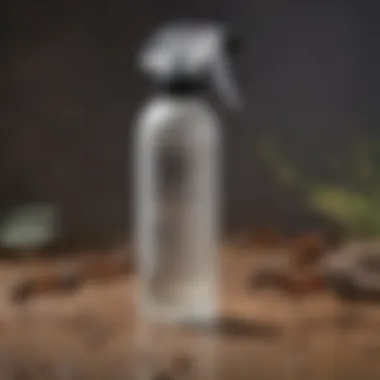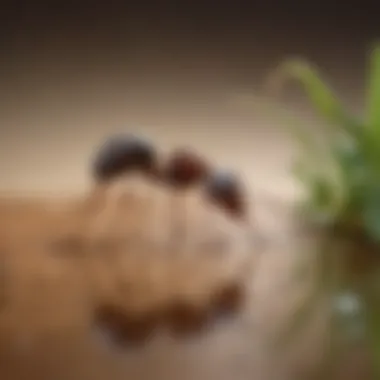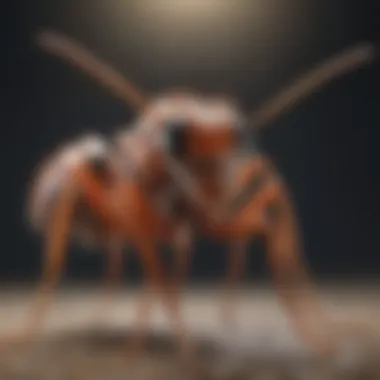Exploring Top Rated Ant Spray: Effectiveness & Safety


Intro
Ants are a common nuisance in many households, often invading kitchens and gardens in search of food and shelter. Understanding how these pests operate, their life cycles, and effective methods for controlling their populations is crucial for homeowners. This article offers a detailed examination of top-rated ant sprays, focusing on their effectiveness in various scenarios, safety for humans and pets, and eco-friendly alternatives.
By gaining insights into ant behavior and learning about preventative measures, homeowners can take a proactive approach to pest management. The following sections will explore important aspects of ant control, including the understanding of the pests themselves, strategies for prevention, and various control methods available. By synthesizing this information, readers will have a strong foundation for making informed decisions about ant control solutions.
Prelude to Ant Control
Effective ant control is vital for maintaining an organized and healthy home environment. Ants are not just a nuisance; they can compromise food safety, cause structural damage, and even lead to infections. Recognizing the significance of addressing ant infestations is the first step towards effective management. This section aims to set the stage for understanding the dynamics of ant control, focusing on the importance of selecting the right control methods, both for immediate relief and long-term solutions.
Importance of Effective Ant Control
Ants can quickly turn from a minor annoyance to a major problem if not managed properly. They invade homes in search of food, and their colonies can expand rapidly, escalating the infestation. An effective ant control strategy not only eliminates the current problem but also deters future infestations. This dual approach saves homeowners time, effort, and money. Furthermore, choosing the right ant spray can ensure that treatment is administered safely with minimal impact on the environment and non-target species. The integration of user experiences and scientific research in selecting ant sprays enhances their effectiveness.
Overview of Ant Species
Understanding the various ant species that inhabit residential areas is crucial for developing a targeted control strategy. Common species such as the Carpenter Ant, Argentine Ant, and Pavement Ant exhibit different behaviors and preferences.
- Carpenter Ant: Known for their nesting in wood, these ants can cause structural damage.
- Argentine Ant: Characterized by their aggressive foraging habits, they may displace other native ant species.
- Pavement Ant: Often found in urban settings, these ants are scavengers, frequently raiding homes for food.
Each species may require a different approach for management. Homeowners benefit from understanding these differences, which can lead to more effective control measures. Failure to recognize the specific type of ant can result in ineffective treatment and continued problems.
"Effective ant control requires more than just eliminating the visible pests; it necessitates an understanding of their behavior and biology to prevent future infestations."
Understanding Ant Behavior
Understanding ant behavior is crucial for effective pest control. Ants are social insects, and their interactions within colonies greatly influence how they respond to different approaches in management. Knowing the intricacies of their behavior allows homeowners and pest control professionals to develop strategies that can disrupt their activities effectively. Ant behavior informs the selection of appropriate sprays and application techniques.
Colony Structure and Functions
Ant colonies exhibit a sophisticated social structure, typically dominated by a queen, workers, and drones. The queen's primary role is reproduction, while workers undertake various tasks such as foraging, caring for the young, and maintaining the nest. Each role ensures the survival and efficiency of the colony. Understanding these functions can guide the timing and location of ant spray applications, leading to higher success rates.
- Queen: Responsible for reproduction.
- Workers: Forage for food, care for larvae, and maintain the nest.
- Drones: Male ants that mate with the queen during nuptial flights.
By recognizing the colony's structure, individuals can target their control methods more effectively, disrupting the worker's foraging patterns or targeting the queen to diminish future population growth.
Foraging and Feeding Patterns
Ant foraging behavior is influenced by the availability of resources and environmental conditions. Ants communicate through pheromones, which help them establish trails to food sources. Understanding these feeding patterns is essential when applying ant sprays as it allows for strategic placement. For instance, if a homeowner identifies common pathways or food sources, they can treat those specific areas for optimal effectiveness.
- Seasonal Patterns: Ant foraging can vary with seasons, often increasing during warmer months.
- Food Preferences: Different ant species have varied diets; some are attracted to sweets while others prefer proteins.
This knowledge helps in both anticipating ant activity and implementing preventive measures to deter infestations before they escalate.
Reproductive Behavior
Ant reproductive behavior typically occurs during the mating season, marked by a nuptial flight. During this period, winged males and females leave the colony to mate. After reproduction, fertilized queens seek a new nesting site, laying the foundation for new colonies. Understanding this aspect is vital; treating areas around potential nesting sites can prevent future infestations. It is instrumental for long-term management strategies that aim to control the ant population before new colonies establish.
"Ant behavior is central to developing effective control measures that are both efficient and non-intrusive."


By comprehending the biological and social dynamics of ants, individuals can make informed choices that effectively reduce ant populations while minimizing harm to non-target species. This knowledge complements the use of top-rated ant sprays, resulting in a holistic approach to pest management.
Formulating Ant Sprays
Formulating ant sprays is a crucial aspect of the ant control discussion. This process involves selecting appropriate ingredients that ensure both effectiveness against ant populations and safety for people and pets. It's not merely about combining chemicals; it requires careful consideration of how these ingredients will interact with ant behavior and their environment. By understanding the chemical makeup and the corresponding behavioral patterns of ants, homeowners can make informed choices about what products to use in their pest control efforts.
Chemical Composition of Top Rated Sprays
The chemical composition of top-rated ant sprays varies widely. Common active ingredients include pyrethroids, which are synthetic versions of naturally occurring insecticides. These are known for their rapid knockdown ability.
- Pyrethroids: They disrupt the nervous system of ants when they come into contact with it. Products containing substances like permethrin or cypermethrin are popular for their effectiveness.
- Boric Acid: This is another effective component. It acts slowly, allowing ants to bring the poison back to the colony, ultimately leading to the colony's demise. This ingredient is more favorable as it poses lesser risk to humans and pets than harsher chemicals.
- Essential Oils: Some sprays offer a more natural alternative, using oils like peppermint or citrus. These oils can deter ants due to their strong scents but may not be as immediately lethal as synthetic chemicals. Their appeal lies in their eco-friendliness.
Understanding these components is essential. Safeguarding both human health and the environment should be a priority when selecting ant sprays.
Mechanisms of Action
The mechanisms of action for ant sprays depend largely on their composition. Each active ingredient works through specific pathways to effectively target ants. Let’s break down how these commonly used ingredients function:
- Neurotoxicity: For instance, pyrethroids work by targeting sodium channels in an ant’s nervous system. They effectively cause disorientation and death when ants expose themselves to the spray.
- Metabolism Disruption: Boric acid can be ingested by worker ants and disrupts their ability to digest food. It interferes with their metabolism, leading to starvation in the long run.
- Social Interaction: As some natural sprays utilize essential oils, they may also impact the communication among ants. The strong scents can mask the pheromones that ants use to navigate, causing confusion in colonies.
Homeowners must consider these mechanisms when using any ant spray. Knowing how an active ingredient works can help in determining the effectiveness of treatment methods, ensuring that the approach taken is both suitable for the targeted ants and safe for the home environment.
Evaluating Top Rated Ant Sprays
Evaluating top rated ant sprays is a crucial step for homeowners seeking effective pest control solutions. These evaluations help in identifying products that provide best results while considering safety and environmental impact. The existing market presents diverse ant spray options, which can lead to confusion. An organized evaluation clearly distinguishes the effective products from those that may not meet expectations.
Factors such as active ingredients, application techniques, and user reviews are essential in this evaluation process; these variables shape the overall efficacy and safety of the products. Understanding effectiveness not only refers to killing ants but also the duration of action and prevention of future infestations. When assessing sprays, one must also consider potential risks to humans and pets, emphasizing safety as a priority.
Criteria for Evaluation
When evaluating ant sprays, several criteria should be considered to do a comprehensive assessment. Below is an ordered list of these criteria:
- Active Ingredients: The composition of the ant spray significantly affects its effectiveness and safety. Chemical versus natural ingredients play a pivotal role in how these sprays perform against different ant species.
- Effectiveness Duration: How long the product remains effective is vital. Some sprays work immediately, while others may provide lasting protection against infestations.
- Application Ease: User-friendliness is key. A product that is easy to apply can improve the user experience and effectiveness. Complexity may result in improper use.
- Safety Profile: An evaluation must include scrutinizing the safety data for humans and pets. The presence of harmful substances should be noted if they could cause allergic reactions or other adverse effects.
- Environmental Impact: Eco-friendliness is increasingly important. Analysing the environmental consequences of using such products can help responsible consumers make informed choices.
- Price Point: Cost effectiveness matters. Higher price does not always mean higher quality but evaluating cost against performance is essential for many homeowners.
- User Feedback: Reviewing actual user experiences can provide real insight into how a product works in practice.
Reviews of Leading Products
In the search for the best ant sprays, certain products have received positive feedback consistently. For instance, Raid Ant and Roach Killer highlights extensive consumer trust due to its quick action. It features a dual-action formula that kills ants on contact and prevents future infestations, making it a popular choice among homeowners.
Another noteworthy contender, Ortho Home Defense Insect Killer, is praised for its long-lasting protection capabilities. Its formula can last up to a year, allowing homeowners to maintain a pest-free environment with minimal effort. Additionally, its ease of use with comfortable nozzles ensures effective application in various settings.
Meanwhile, EcoSMART Organic Insect Killer stands out for those concerned about environmental safety. As a pest control option free from harmful chemicals, this product uses plant oils, offering a safer choice for households with pets and children.
User Experiences and Case Studies
User experiences can greatly inform potential buyers about the effectiveness of ant sprays. Many users report favorable outcomes after consistent use of leading products. For example, a homeowner in New Jersey shared that using Raid significantly reduced the ant activity in her kitchen. She noted a decrease in sightings after a single application, reinforcing the efficacy of the spray.
Similarly, another user from California documented positive results with Ortho Home Defense. After treating her outdoor spaces, she observed a marked drop in both ant and other insect populations. This comprehensive feedback reinforces the importance of understanding the practical applications of these products.
A case study involving the use of EcoSMART reveals its effectiveness in sensitive environments. A mother shared her success in using this product for gardens and play areas, as it allowed her to manage pests without endangering her children's safety.


In sum, evaluating top rated ant sprays involves multiple dimensions, from the ingredients to user experiences. Homeowners can find peace of mind by thoroughly understanding the available options and their implications on health and the environment.
Safety Considerations
Understanding safety considerations is paramount when dealing with ant sprays. This section will elucidate various important factors regarding the impact on humans and pets, as well as environmental safety. Being aware of these factors can greatly benefit householders in making informed decisions about pest control.
Impact on Humans and Pets
Ant sprays often contain a mix of chemical compounds. Some of these chemicals can be harmful to humans and pets if inhaled or if they come into contact with skin. It’s essential to read the labels carefully. Here are a few pertinent points to consider:
- Toxic Ingredients: Many ant sprays may include ingredients like pyrethroids or neonicotinoids, which can cause respiratory issues or skin irritation.
- Children and Pets at Risk: Young children and pets are at higher risk of exposure due to their behavior. Pets might lick surfaces where sprays have been applied, leading to potential ingestion.
- Protective Measures: Use gloves and masks during application. Restrict access to treated areas until sprays have dried completely.
The key is to choose sprays that emphasize safety. Look for products that specifically state they are safe for pets and children. Always consult a professional if unsure about an ingredient.
"Choosing the right ant spray means prioritizing the safety of your loved ones, both human and furry."
Environmental Safety
The impact of ant sprays on the environment cannot be overlooked. Many household insecticides can pose risks to non-target species and the broader ecosystem. Here are necessary considerations:
- Non-Target Species: Traditional sprays can harm beneficial insects like bees and ladybugs, essential for pollination and pest control.
- Water Pollution: Chemical runoff can contaminate waterways. This might harm aquatic life and impact drinking water quality.
- Bioaccumulation: Some chemicals can accumulate in the food chain, potentially affecting wildlife and, ultimately, human health.
Opting for products labeled as eco-friendly can minimize these risks. Integrated pest management approaches, which focus on prevention and natural options, are also beneficial. They encourage a balance, reducing reliance on synthetic chemicals.
In sum, ensuring the safety of humans, pets, and the environment should be a top priority when selecting and applying ant sprays. This careful consideration not only protects your immediate surroundings but also promotes a healthier ecosystem.
Eco-Friendly Alternatives
In recent years, the focus on eco-friendly alternatives in pest control has gained momentum. This change is fueled by increasing awareness of environmental issues and a growing desire to use safe products around our homes. Incorporating eco-friendly options in ant control not only aids in effective pest management but also reflects a responsible approach to the care of our environment.
Eco-friendly alternatives offer numerous benefits. They are often safer for humans and pets, reducing the risks of harmful chemical exposure. Products made from natural ingredients tend to have lower toxicity levels, which aligns with a household's need for safety and security. Moreover, utilizing these alternatives can minimize chemical runoff into the environment, thus protecting local ecosystems.
When assessing eco-friendly pest control options, it is essential to consider their effectiveness alongside safety. Many traditional pest control solutions can harm beneficial insects and wildlife. Therefore, choosing sustainable methods can promote a balanced ecosystem. This article will explore various aspects of eco-friendly pest control solutions, focusing on natural ingredients, homemade remedies, and integrated pest management strategies.
Natural Ingredients in Pest Control
Natural ingredients play a significant role in eco-friendly pest control. Various plant-derived substances possess insect-repellent properties without the adverse effects found in synthetic chemicals. For instance, essential oils such as peppermint, tea tree, and citrus can deter ants effectively. These oils not only mask the pheromone trails ants use for navigation but also disrupt their behavior, leading to decreased activity around treated areas.
Utilizing natural ingredients comes with advantages. They are typically biodegradable and do not contribute to long-term soil or water pollution. Additionally, many of these substances are easily accessible and cost-effective, allowing homeowners to engage in pest control without breaking the bank. However, it is important to note that while natural products can be effective, their results may vary based on the environment and specific ant species present.
Homemade Remedies
Homemade remedies provide another avenue for eco-friendly ant control. These solutions can be tailored to specific needs and preferences, often using simple ingredients found around the house. Common options include a mixture of water and vinegar, soap and water solutions, or sugar and borax bait.
Using vinegar as a spray can disrupt ant trails while acting as a cleaner. A soap and water combination can suffocate ants on contact. This approach not only removes ants but also serves as a preventative measure against future infestations. Borax, combined with sugar, can attract ants and eliminate them while being safer than many commercial pesticides.
Homemade remedies highlight the importance of resourcefulness. They offer an accessible and often lower-cost alternative to store-bought sprays. Nevertheless, homeowners must remain caution regarding any potential allergens or sensitivities, particularly involving pets and children in the household.
Integrated Pest Management Strategies


Integrated pest management (IPM) strategies represent a holistic approach to pest control. IPM combines biological, cultural, and mechanical methods to fend off pest populations while minimizing the reliance on chemical treatments. This method emphasizes understanding ant behavior and the environment to implement the most effective solutions tailored to specific situations.
Key components of IPM include monitoring ant activities, identifying species, and utilizing non-chemical solutions as first steps. Homeowners are encouraged to maintain cleanliness and address external conditions that attract ants, such as food sources and shelter opportunities. By recognizing how ants thrive, individuals can proactively manage their properties.
Moreover, when necessary, IPM integrates targeted chemical solutions, prioritizing low-risk options. This balance allows for thorough pest control with minimal environmental impact. Encouragingly, many pest control professionals are adopting IPM strategies, reflecting a move toward more sustainable practices in the industry.
Eco-friendly pest control represents an intersection of efficacy and responsibility, making it a vital consideration for sustainable living.
Application Techniques for Ant Sprays
Effective application techniques are crucial for maximizing the effectiveness of ant sprays. These actions determine not only how well the product works but also its safety for humans and pets. Timing, location, and the dosage of application can significantly influence outcomes. Understanding these aspects can lead to better pest management and ultimately a more harmonious living environment.
Timing and Location of Application
The timing and location of applying ant sprays are essential elements. Applying spray at the right time can make it more effective. For example, early morning or late evening is often recommended, as ants are more active during these times.
- Identify Ant Activity: Observing when ants are most active can guide the best times for application.
- Seasonal Considerations: Ants often enter homes during warmer months, so applications may be more effective in spring and summer.
- Location Specifics: Targeting areas where ants are frequently seen can improve results. Focus on entry points, trails, and nesting sites.
It's key to avoid areas where pets and children play during application to ensure safety.
Dosage Recommendations
Correct dosage can enhance the safety and efficacy of ant sprays. Overapplication can lead to unnecessary exposure to chemicals, while underapplication may fail to eliminate the problem.
- Read the Label: Always follow the manufacturer's instructions regarding dosage. These guidelines are based on research and ensure that the product is used safely.
- Measure Accurately: Use measuring tools to ensure the correct amount of spray is applied. This reduces waste and potential harm.
- Reapply as Needed: Evaluating the ongoing ant problem may require reapplication. However, adhere to recommended intervals between applications to avoid buildup in the environment.
"Understanding how to apply ant sprays effectively can transform pest control into a manageable task for homeowners."
The knowledge of proper timing and dosage not only optimizes the effectiveness of the sprays but also helps in maintaining a safe household. Keeping these practices in mind encourages a healthier approach towards ant control.
Finale
The conclusion is a vital section of this article. It brings to light main points discussed throughout and reinforces the importance of effective pest control strategies. Understanding various ant sprays aids not just homeowners in making informed decisions, but also educates them about methods that promote safety and ecological balance.
In this article, we highlighted the effectiveness of top-rated ant sprays, addressing their chemical composition, safety for humans and pets, as well as their environmental implications. This balanced approach provides a holistic view, making it easier for consumers to choose the right product that aligns with their needs.
Another benefit of this exploration is the insight into eco-friendly alternatives. As awareness about environmental issues increases, many are seeking ways to manage pests without contributing to ecological harm. Thus, the integration of natural ingredients and homemade remedies expands the toolkit available for effective ant control.
The information gathered can be instrumental in future pest management strategies. Homeowners who understand ant behavior, as outlined, are better equipped to act accordingly. This deeper understanding of pest control contributes to more efficient and effective household management overall.
Summary of Key Findings
Key findings of this article include:
- The effectiveness of top-rated ant sprays varies based on their chemical composition and intended application.
- Safety for humans and pets should be a priority when selecting ant control products.
- Eco-friendly alternatives, such as natural ingredients and homemade remedies, can be highly effective for pest management.
- Understanding the behavior and biology of ants provides insights into more efficient control methods.
"Knowledge about pest control and ant behavior empowers homeowners to make better choices, ensuring safety and efficiency."
Future Perspectives in Ant Control
Moving forward, the landscape of pest control will evolve as new research emerges. Ant control will likely focus more on integrated methods that combine traditional sprays with eco-friendly approaches. The shift towards sustainability is already influencing product development in this sector.
Innovation in formulations may also continue, leading to more effective yet safe solutions for ant control. As societal values around health and environment change, manufacturers will need to adapt and create products that not only work effectively against pests but are also safe for family and pets.
Additionally, educating consumers about the importance of proper application techniques and timing will remain crucial. As products become more sophisticated, the knowledge of how to utilize them effectively will be key in pest management success.







